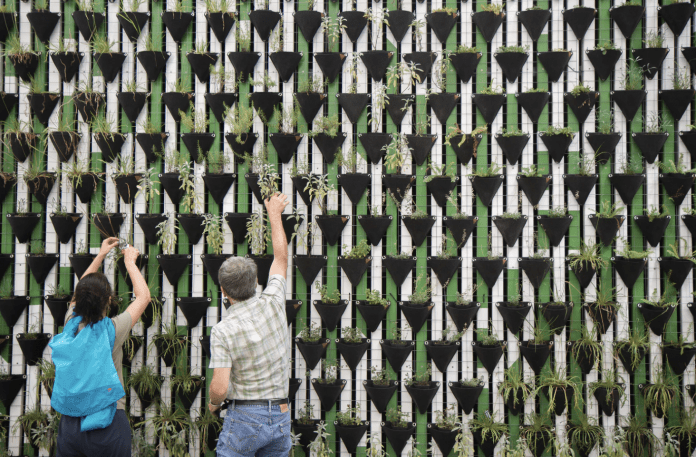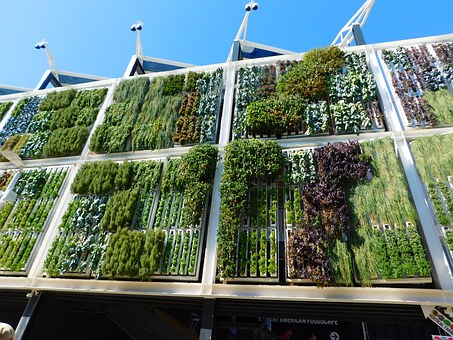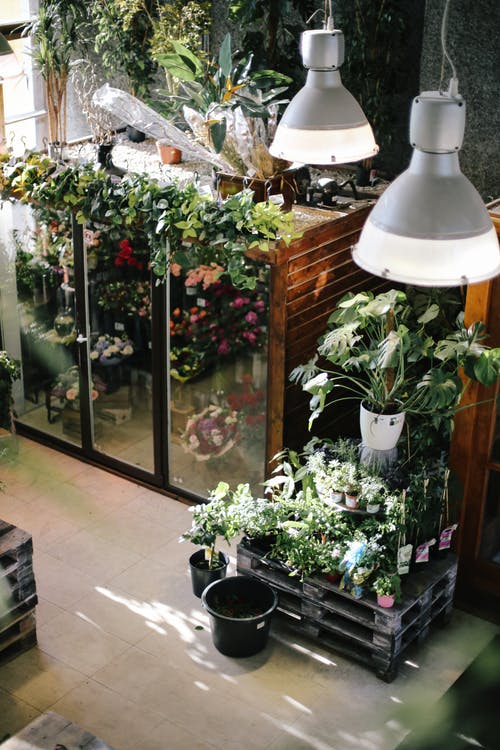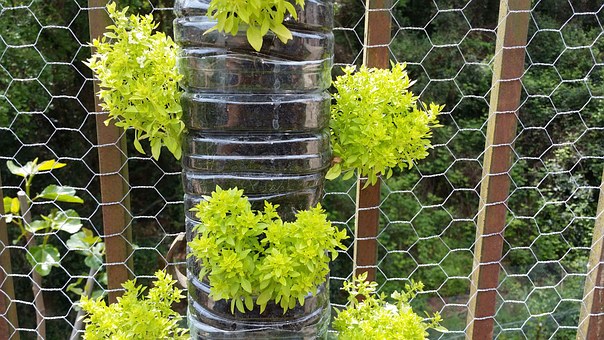
It’s time for many of us to literally grow up because we’re discussing something called a grow tower. This vertical grow system allows all varieties of plants to grow straight up. They are catching on fast because they take up far less space, conserve water, and can be easy to maintain. Grow towers make gardening easy. Even people with “brown thumbs” can get growing fast without all the hassles of digging and maintaining a traditional garden. Even better, people with mobility issues can harvest crops while standing up with some of the taller vertical grow systems.
Actually, many people are creating their own handmade grow towers, but there are many great models now available for purchase online too. We will review some of the best grow towers widely available on the market. Your next gardening project may be just a few clicks away and delivered to your door shortly.
Keep in mind that some people refer to the models that use traditional potting soil as “tower gardens” and those that use a hydroponic growing method as “grow towers.” However, as you’ll see, the models below are often a hybrid of the two. There is a lot of flexibility to customize and to pick a garden growing system that works just right for you.
Comparison Table
No products found.
Things to Consider When Picking a Grow Tower
Image Via pixabay
Here, we’ve compiled some of the basic concerns you’ll no doubt want to think about before making a purchase.
Cost
As you can see with a quick search online, the cost varies enormously, from cheap to very expensive for those who just can’t get enough, or who grow on a commercial scale. For the models we’ll examine, the models will be from average to high price range.
Space available
A grow tower can be as big or small as you like. In our examples, the models reviewed below vary from the size of a barrel drum to the size of a loaf of bread. You can customize them to fit any size space you need, which makes them an outstanding choice for apartment or condominium dwellers who have little outdoor space.
Plant types
Many people want to produce fresh organic vegetables right at home. On the other hand, some people want to grow ornamental plants. The most exciting part is that you can use a grow tower for whatever you want to grow and in places that you probably don’t even realize are possibilities. The sky is the limit.
Maximum number of plants
To start out, consider the maximum number of plants you want to grow. Some models boast the ability to produce 50 plants in four square feet of space. Others are much more modest, allowing only a few small plants. With models that are stackable or customizable, then you can always add on more room.
Location
You may use most of these grow systems indoors or outdoors. If used outdoors, then it will depend on your climate and also the time of year. Grow plants that tolerate the cold during the colder months for those who don’t live in tropical areas. Otherwise, you can use artificial lighting or a greenhouse to allow the use of your grow tower every day of the year. Equally important, they have the versatility of doing double duty so that you can grow outdoors during the warmer months and then you can transport them inside once it is too cold.
High humidity in the home
One thing to consider is that, although they look tidy growing straight up, you could also inadvertently damage floors, walls, or other furnishings due to all the moisture. You can expect to have some stray dirt, growing medium, or leaching of minerals in the case of some hydroponic systems. However, if you take reasonable care to protect your home with water-proof coverings like plastic, then there may not be much if any problem. It’s just something to consider. Nobody who rents wants to pay back that security deposit for messing up a floor or wall. It’s something to keep in mind.
Maintenance
Likewise, be sure to keep in mind that you may have to buy timers, growing mediums, nutrients, and irrigation systems separately for your initial grow tower investment. Then add on as much as you like and make it as easy or complex as you desire. The level of maintenance is really up to you, although some cases will require more work than others. One example: If your tower is in a hot, dry climate where water evaporation is rapid, you’ll spend more time watering the plants.
Size and weight
The total size and weight will be important, especially for those who want to move a grow tower from outdoors to indoors. However, some models are now conveniently on wheels. You can easily position them despite the considerable weight of a fully planted and watered tower. Now that’s progress!
Growing Mediums
Let’s dig into the details of the two main substrates, one of which you already know for sure.
Image Via pexels
Soil
Another consideration is that a grow tower accommodates many different growing mediums. Many people prefer to use potting soil. It’s what they are most familiar with, and it’s easy to obtain. No necessary chemicals for pH and fertilization are needed, and with organic mixtures, you have the confidence of growing the purest, healthy vegetables.
Hydroponic systems
In the case of hydroponic systems, you won’t use typical soil. The gardener provides a unique nutrient solution for the plant’s roots. The medium the roots grow in only provides a place for the roots to anchor the plant in place. Some people use a medium called Rockwool made from spun basaltic rock fibers. It’s also a thermal insulation material in the construction industry. Interestingly, there has been much debate if Rockwool could be a carcinogen or harmful to one’s health.
No products found.
Hydroponic systems
Other gardeners use coconut coir, also called coco peat or coco slabs that are expanded with water and provide a lovely natural and renewable alternative medium to Rockwool. Even better, coconut coir makes use of the coconut husks that would otherwise end up in a landfill. Given these points, the only drawback is coconut coir might hold water too well, water logging plants in some cases.
Aeroponic systems
Aeroponic systems are a more complex type of hydroponic system that mists the plants’ root systems continually with a nutrient solution. The grow towers we are looking at won’t provide this type of system.
No products found.
Lighting
Image Via pexels
If your grow tower is outdoors, you can take full advantage of the sun’s rays. You can rotate many of the systems to expose plants in the shadows to the sun whenever you like. It’s a great option when your tower sits against a wall or corner. It also keeps the plant growth uniform as the leaves reach out for the precious sunlight in all directions rather than to one side.
Very briefly, if you grow your plant indoors, then you’ll rely on grow lights unless you have the perfect spot near a window or sunroom. There are now many LED lighting systems for plants, but the typical fluorescent lights made for growing plants are an old stand-by. Since LED lights are becoming more and more affordable and are so energy efficient, they are often worth a higher initial investment. Whatever lighting system you choose, consider the additional cost when you select your grow tower.
Special Features
Let’s narrow down some of the reasons why one design might appeal to your specific gardening goals more than another.
Space for roots
In some cases, a grow tower may have very little space for the root systems. Other models have a deep, more typical pot that will allow for more medium and thus larger root systems. This can be a benefit for those in very hot climates, where smaller pockets of dirt could dry out quickly. Of course, if you have an automatic misting system, that wouldn’t be an issue anyway.
Composting ability
Some models offer a special tube in the center for compost and introducing beneficial earthworms. While worms might not be every gardener’s cup of tea, they can provide fertilizer to plants. Once you introduce them, you can easily feed them compost you make at home or buy from a store.
Design
Keep in mind: The grow towers all look totally different without plants in them, but that will soon change. Don’t necessarily judge the green book by its cover, since plants will eventually grow out and cover the surface of the tower anyway. Depending on what you plant, the tower will completely vary in appearance. It’s part of the art of gardening that makes it so much fun. As you will hopefully see, the aesthetics of the tower design can bring you endless enjoyment even when it’s the dead of winter outside.
Extras
Now let’s look at the bells and whistles! Some models utilize a pump to circulate the water through the system. Others have a deep water reservoir, but still, require regular watering. You can customize some of them to take advantage of a drip system. With the addition of timers, all you have to do is sit back and enjoy. However, those that still like getting their hand’s dirty can go at it as much as they want. Get your fix of gardening all year round. Or, on the other hand, set a timer and go read a book or catch a movie instead while your plants grow.
How We Reviewed the Best Grow Towers
Image Via pixabay
We reviewed the following models by looking at their availability online, favorable customer reviews, flexibility, ease of use, attractive design, and cost. There are many countless models on the market as grow towers are also growing in popularity. We hope this list will make it easier for you to start your garden and see what’s available. It will give gardening enthusiasts and novices a quick reference and hopefully encourage you to jump, or should we say, dig in.
Our Top Picks of the Best Grow Towers
Now the moment we’ve been waiting for: Let’s check out grow towers just a click away for purchase. Will you see one you just can’t live without?
No products found.
No products found.
This tower could grow 40 plants in just four square feet. The large and robust tower allows for deep root systems. It’s big and heavy, but it also spins like a carousel for easy access to all plants. Some of the models come with built-in wheels too, making it very easy to move around. It’s so large, it’s much better for use with potting soil mixtures. You’ll want to pick one that is nice and fluffy with additives like perlite, coconut coir, or peat moss. You get the idea: Don’t go for something heavy and bulky.
One of the very best features of this model is the “vermicomposting” nutrient delivery system in the middle tube. This system allows the use of compost with red wiggler worms or earthworms which produce beneficial worm castings for the plants. The thought of worms might not be appealing to you, but it’s definitely optional. There is a reservoir below the unit to conserve water use.
No products found.
No products found.
This grow tower comes in black, brown, stone, and green colors. A family-run business manufactures them entirely in East Tennessee. The company points out the plastic is BPA-free and UV-resistant with a five-year warranty.
The GreenStalk has a patented watering system: Put water in the top water reservoir to water all of the lower tiers. Like the previous model we looked at, the medium will be potting soil, and you can pick organic varieties to ensure fewer chemicals in your food.
Although it doesn’t come standard, you can buy a wheeled base and rotate or relocate the grow tower easily. This is great because it weighs about 150 lbs. when fully planted and watered. The manufacturer suggests planting larger plants at the bottom and smaller ones at the top. That way, the larger plants don’t shade the plants below them.
No products found.
No products found.
This versatile system varies in cost for a single unit. You can choose black, stone, or terracotta colors, but keep in mind, the plant leaves may cover much of the design eventually. Change up the design by stacking the versatile pots up to 10 pots high.
You can use this model as a hydroponic system. Instead of potting soil, the manufacturer recommends using a mixture of 75 percent coco peat and 25 percent perlite. If you don’t want a hydroponic system, you can use regular soil, but they don’t recommend this. Some models can accommodate 20 smaller plants in the space of 18.5 inches by 18.5 inches.
As a hydroponic system, you’ll need some extras, like the seven-day digital timer for automatic watering available on some models. Another option you’ll want is the 250 GPH submersible pump that circulates the water and nutrient solution from a 16-gallon tank. You purchase may come with a nutrient solution to start you off, and grow medium is sometimes available if you register your product with the company website.
No products found.
No products found.
This vertical growing system ranges from cheap to average price tag. Obviously, the best parts are the extremely inexpensive price, but it’s also quite versatile too. It’s simple to set up and use, mounting to a wall or fence from a rod or hooks.
The felt cloth, 7-Pocket Wall Hanging Planter measures 40 by 11.8 inches but comes in many different sizes. Since it consists of water-absorbent cloth, it’s not the best choice for full sun since seedlings can dry out relatively fast.
On the other hand, it’s easy to transplant the plants to other spots or containers. You can use it indoors or outdoors, but since moisture goes through the fabric, it can damage walls or floors if you don’t use plastic liners. You can do this easily with trash bags. You’ll most likely want to do this if you use the pocket hanging garden indoors.
Unless you set up your own drip system, you’ll need to water each pocket individually, so there may be more maintenance as a trade-off for that cheap price.
No products found.
No products found.
These hybrid models vary in cost. This is an aesthetically pleasing “introduction to vertical gardening” that stands up to five feet tall. This could be great for those who don’t enjoy lots of bending and stretching. Just harvest plants right in front of your eyes. The tower rotates for easy access to sunlight exposure for the plants as well.
The manufacturer says it’s easy to move and set-up and is perfect for indoor or outdoor use. The stacking pots allow full, deep root systems. The company suggests the system is ideal for all climates due to this feature. That’s because plants with full root structures aren’t as likely to dry out fast in hot climates.
With this model, you could grow up to 40 plants in two square feet of space. It’s a hybrid because while it uses potting soil, it also has a reservoir at the base that uses hydroponic liquid nutrients you’ll need to purchase separately. You don’t have to use the hydroponic component, but it also might be fun to try if you want.
No products found.
No products found.
These may appear to be a “grow wall” rather than a “grow tower.” You could use the system inside or outdoors and it comes in grey, terracotta, and green. It’s straightforward to secure the lightweight pots to the wall using regular screws. On the other hand, the pockets can also clip to the bottom of one another.
The planters with three pockets fit together, covering as much wall space as you desire. The automatic dripping system allows water to drip down from the top row of planters to the lower ones, and a nine-foot hose delivers the water to the top row of containers. The manufacturer states that the hose fits American standard tap fixtures. The system has a three-year guarantee.
No products found.
No products found.
These handmade grow towers vary in cost. They are charmingly handmade and the company states each tower is made from “PVC and love.” Each tube has eight vertically placed plant sites on a thin tube that mounts to just about any vertical surface.
One great feature is that these will hang on chain link fence without the need for tools. They are easy to use with potting soil, but the seller can customize them for hydroponic use if you ask. The FenceFarm requires watering every other day unless you create your own drip irrigation system above it.
The Best Grow Tower
Although it has a higher initial investment, the Garden Tower 2 really does check off a lot of boxes for a perfect grow tower. It has great features such as the composting tube in the center tower, wheels for easy mobility, and a large size that can produce a ton of vegetables or other plants.
All of the other models are great for those who want to start a garden without investing as much as the Garden Tower 2. The pocket hanging vertical gardens offer an unbeatable price, which will no doubt be appealing to many just starting out. There are many competitors and the pocket gardens come in many colors and sizes. Wherever you decide to place it, keep in mind that the fabric is going to be wet at times.
A special mention goes out to the handmade FenceFarm because they obviously make them with love and you can easily attach them to any chain-link fence in minutes. We hope this gives you a great start to finding the perfect grow tower for you. May you see many new green possibilities springing up in unexpected places around you.
Featured Image via Unsplash
Last update on 2022-01-27 at 20:02 / Affiliate links / Images from Amazon Product Advertising API







